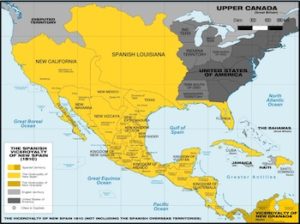
New Spain, 1800
*Slavery in New Spain is affirmed on this date in 1521. This episode was important to the expansion of white European business into the western hemisphere. Spanish slavery began with the Greeks, Phoenicians, and Romans. In the 9th century, the Muslim Moorish rulers and local Jewish merchants traded in Spanish and Eastern European Christian indigenous slaves.
The Spanish enslavement of Africans began with Portuguese captains Antão Gonçalves and Nuno Tristão in 1441. Three years later, the first large group of enslaved Africans, 235 enslaved people, came with Lançarote de Freitas. In 1462, Portuguese slave traders began to operate in Seville, Spain. During the 1470s, Spanish merchants began to trade large numbers of enslaved people. Enslaved people were auctioned at the market at a cathedral and transported to cities all over Imperial Spain.
This led to the spread of Moorish, African, and Christian slavery in Spain. By the 16th century, 7.4 percent of Seville, Spain, were slaves. Many historians have concluded that Renaissance and early modern Spain had the highest number of enslaved Africans in Europe. After encountering indigenous people in the New World, the Spanish colonialists decided to use it for commercial production and mining because of the absence of trading networks.
During the Middle Passage, after the Spanish conquest of the Indigenous Aztec empire, conqueror Hernán Cortés named the territory New Spain. They established the new capital of Mexico City on the site of the Tenochtitlan, the capital of the Mexica (Aztec) Empire. Central Mexico became the base of expeditions of exploration and conquest, expanding the territory claimed by the Spanish Empire.
Its jurisdiction comprised a huge area that included Mexico, much of the Southwestern U.S., and California in North America, Central America, northern parts of South America, and several Pacific Ocean archipelagos. Spain began to trade enslaved people in the 15th century, and this trade reached its peak in the 16th century. The Native American population was the laborers, but they died in large numbers because of war, diseases, exploitation, and social disruptions. Meanwhile, the need for labor expanded, such as sugarcane production.
The problem of the justness of Indian slavery was a key issue for the Spanish Crown. Bartolomé de las Casas was concerned about the fate of the natives and argued in 1516 that white and black slaves should be imported to the Indies to replace the Amerindians. Enslaved Africans did have certain advantages over native enslaved people, such as being resistant to European diseases and having more familiarity with agricultural techniques. This preference led to the development of the Atlantic Slave Trade. Charles V gave a definite answer to this complicated and delicate matter.
To that end, on November 25, 1542, the Emperor abolished the enslavement of natives by decree in his Leyes Nuevas New Laws. This bill was argued by the best Spanish theologists and jurists who were unanimous in condemning such slavery as unjust; they declared it illegitimate and outlawed it from America—not just the slavery of Spaniards over Indians—but also the type of slavery practiced among the Indians.
The labor system of Encomienda was also abolished in 1550. However, these laws did not end the practice of chattel slavery or forced labor immediately. A new system of forced native Indian labor began in Peru. Eventually, this system too was abolished due to abuses. By the 17th century, forced indigenous labor continued illegally, and black slave labor was legal.